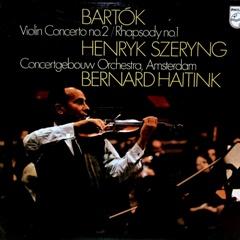Bartok – Violin Concerto No.2 Rhapsody No.1 (Szeryng) [1969]
Bartok – Violin Concerto No.2 Rhapsody No.1 (Szeryng) [1969]

1. Violin Concerto No. 2 1. Allegro Non Troppo 16:25 2. Violin Concerto No. 2 2. Andante Tranquillo 9:03 3. Violin Concerto No. 2 3. Allegro Molto 12:22 4. Rhapsody No. 1 9:50 Henryk Szeryng - violin Concertgebouw Orchestra Bernard Haitink – conductor
Bartók's lifelong interest in variation as a compositional stratagem found its fullest expression in this Concerto, which he completed in 1938. Bartók had been at work on the Music for Strings, Percussion and Celesta when his close friend, violinist Zoltán Székely, asked him for a concerto. Bartók initially planned a large-scale theme-and-variations work, but Székely indicated a preference for a traditional, three-movement work. Bartók's response was ingenious, preserving his own plan for variations within the framework of three movements. The middle movement, Andante tranquillo, follows a traditional theme-and-variations plan, while the finale is a large-scale variant of the first movement. Székely gave the first performance in Amsterdam in 1939, with the Amsterdam Concertgebouw Orchestra conducted by Willem Mengelberg. That premiere was recorded on 78 rpm shellac discs; the recording has been released to the public, and while its sound quality can at best be called poor, it preserves Bartók's own tempo and balance preferences. Over measured B major chords from the harp, punctuated by pizzicato low strings (which sound the five-note motif, B-F sharp-A-E-B, that is the foundation of all the concerto's thematic material), the soloist launches a noble theme in verbunkos rhythm, a long-breathed melody of forthright optimism that immediately places the concerto in Olympian altitudes. In keeping with the Apollonian poise of this Allegro non troppo, the accompaniment is often light and sparing, achieving maximum coloristic effects with minimal scoring (despite the fact that the orchestra is fairly large, with woodwinds in pairs, four horns, three trombones, and a large percussion section). The second theme, marked risoluto, is playful but highly chromatic, with chattering woodwinds accompanying. The main theme returns more than once, like an informal ritornello, in the course of the movement, which Bartók shapes palindromically. Toward the end there is a difficult cadenza almost entirely in double stops and chords. Given the importance of variation technique to Bartók's musical rhetoric, it's interesting to note that aside from a few piano pieces, this concerto's second movement is his only large-scale essay in theme-and-variations form. With soft taps from the tympani beneath, the soloist brings forth the tender and limpid theme that is then treated to six highly differentiated variations. The brusque unison string phrases that open the finale are related to the five-note motif heard at the work's outset. They are answered by the soloist's capricious variant of the opening theme. The themes of the first movement have been, in Bartók's characteristic fashion, elaborated and extended, but their relationship to the first movement is always clear, not least because the structure of the finale closely follows that of the Allegro non troppo. Particularly charming is a waltz-like version of the theme that occurs before the final rush to climax, in which the five-note motif is transformed into the more emphatic four-note phrase (B-A-D-B) that ends the work. Bartók's original ending, in which the soloist was silent during the concluding tutti, was rejected by Székely, who wanted a finish that was more like a concerto instead of a symphony. Bartók obliged with an alternate ending, which is the one generally used, but he appended the original ending to the published score. It features some fearsome forte arpeggios for the three trombones. ---Mark Satola, Rovi
Bartók wrote two rhapsodies for violin and piano, and this, the first one, is generally the more often performed. It exists in two versions, the latter having a different ending. The composer apparently favored the revised edition, since he chose it for both his recordings of the work with violinist Josef Szigeti.
Bartók cast the rhapsody in two sections, or parts, called Prima Parte, marked Moderato, and Seconda Parte (Allegretto moderato). The themes in them are derived from folk dances, and just one hearing divulges the mostly ethnic Romanian flavors permeating the fabric of the two movements. Something has been made of the fact that for once the composer would not divulge the exact sources of the melodies, only that their roots were Hungarian and Romanian. (Later, he tacitly revealed that they were largely Transylvanian, and therefore officially Romanian in origin.) The vigorous opening dance tune, played exclusively by the violin, is colorful and chipper, the piano providing lively, mostly rhythmic support. The middle section in this ternary-form movement is subdued and features an exotic melody, again played by the violin. The opening material is reprised and the first part ends quietly.
The piano opens the Seconda Parte in a slightly hesitant manner, but all tentativeness ceases when the violin announces the joyous, proud main theme. Again, ethnic flavors abound, this time amid various sonic effects, the violin squeaking and grating with sul ponticello-like sounds, the piano turning more percussive and forceful as the movement progresses. Oddly, the main theme here sounds like a sped-up version of the first half of the now-famous (folk) tune Aaron Copland used in his Appalachian Spring. Three other themes appear, and the whole movement is showered with brilliant colors and a sense of gaining momentum. In the first version the piece ends with a recalling of the main theme from the Prima Parte, followed by a rubato cadenza. The second version features a reprise of the opening dance tune in the Seconda Parte and a brilliant coda. Either rendition offers an effective conclusion to this delightful work. --- Robert Cummings, Rovi
download (mp3 @320 kbs):
uploaded yandex 4shared mega solidfiles zalivalka cloudmailru filecloudio oboom uplea
